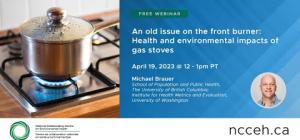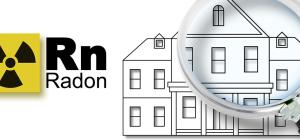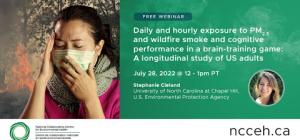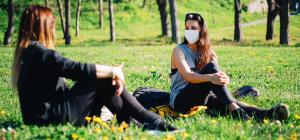
COVID-19 and indoor air: Risk mitigating measures and future-proofing

Humans spend approximately 80-90% of their time indoors and indoor air quality (IAQ) is a key determinant of individual and population health. The COVID-19 pandemic has sharpened the urgency around improving indoor air quality (IAQ) due to the heightened risks of respiratory viral infection in indoor spaces compared to outdoors. Improvements to IAQ may be important to reducing transmission of respiratory viruses but can also impact other IAQ concerns such as sick building syndrome, climate resilience (wildfire smoke responses), and improving productivity and occupant satisfaction generally. A re-examination of the indoor environment is needed to plan ahead for the emergence of new variants of the SARS-CoV-2 virus, and to understand ongoing risks if endemic COVID-19 persists in the longer term, alongside other respiratory pathogens.
Environmental Health Services at the BCCDC, in collaboration with the NCCEH, was commissioned by the BC Public Service Agency to address five research questions to better understand the relationship between COVID-19 transmission and indoor air. This work was intended to inform both current and future strategies to ensure healthy IAQ and provide a holistic perspective on SARS-CoV-2, with a focus on environmental factors and the role of ventilation in particular. This blog presents some highlights of an evidence review carried out in March 2021. Detailed findings, the literature search methodology and references can be found in the full document: COVID-19 and indoor air: Risk mitigating measures and future-proofing.
Research Question #1: What is the risk of transmission of SARS-CoV-2 in indoor spaces via various transmission pathways?
- The transmission of SARS-CoV-2 in indoor spaces is influenced by a combination of biological and physical mechanisms of viral transmission, with several pathways by which the virus can move from an infected person to a new susceptible host.
- Evidence to date suggests that most transmission occurs as a result of close contact interactions (short-range exposure to respiratory emissions).
- The virus may transmit opportunistically over a longer distance where there is a high source load of virus in the air and in poorly ventilated environments where there is poor clearance of accumulating particles, and over longer durations of exposure.
- Other routes of transmission such as via contaminated surfaces (fomites) and fecal-aerosol transmission may be occurring, although direct evidence of this is limited to date.
- Ultimately, an individual’s risk of becoming infected by SARS-CoV-2 depends on various factors operating at multiple scales: personal behaviours and individual susceptibility, the favourability of local environments, and the overall prevalence of COVID-19 transmission in the community.
Research Question #2: How does the emergence of new variants influence the risk of transmission indoors?
- At the time of writing, four variants of concern (VOC) are known to be spreading in Canada, commonly referred to as Alpha, Beta, and Gamma and Delta, all of which are more transmissible, and have become more prevalent among new cases of COVID-19 than previously circulating strains. Some variants may confer a higher risk of mortality or ability to evade natural and vaccine-induced immunity.
- There is no evidence that the pathways or mechanisms of transmission have changed, but variants may transfer more efficiently and hence a smaller dose, over a shorter duration of exposure, can cause infection. Infected persons may also shed more virus and be infectious for longer; therefore, risks from all transmission routes are heightened.
- Further VOC are likely to emerge in the future, but reducing community spread and ensuring good adherence to current public health recommendations will reduce the chance of these taking hold, in combination with improved surveillance, genomic testing, and achieving widespread vaccination.
Research Question #3: What are the key factors that exacerbate the risk of transmission indoors?
- Risks of becoming infected by SARS-CoV-2 vary depending on the prevalence of COVID-19 transmission in the community, host factors, personal behaviour, including mask-wearing, and the micro-environment including the physical characteristics of the space (size, layout, and environmental controls) and how users interact within the space (density of users, duration of interaction and nature of activities).
- Spaces characterized by crowding, high frequency, duration and proximity of interactions, enclosed spaces with limited ventilation, and locations with absent or poorly implemented controls have featured in COVID-19 clusters and outbreaks.
- Small, enclosed, and poorly ventilated spaces with possible directional airflows can affect the likelihood of exposure, as can occupants behaviour and activities.
Research Question #4: What strategies are most important for mitigating risk, and how can we estimate the impact of various measures?
- The objective of risk mitigation measures is to reduce community level impacts by slowing infection rates, reducing overall case numbers, and reducing pressure on public services such as hospitals, to allow time for vaccines to be distributed.
- Risk mitigation should be equitable and applied in a layered approach, with the hierarchy of controls offering one approach to identifying and applying mitigating measures to eliminate or reduce potential exposures.
- Engineering controls sit higher on the hierarchy of controls (see more on physical barriers, ventilation, air cleaners, disinfection, CO2 monitors), but may be slower or more expensive to implement than some administrative or personal protective measure (see more on masks), leading to potential equity concerns.
- Few interventions have been investigated with respect to reducing SARS-CoV-2 transmission; however, we assume that these technologies are likely still beneficial based on research on other illnesses or other IAQ contaminants (e.g., removal of particulate matter).
- Once a risk mitigation strategy has been implemented, it is critical to review and revise, with continuous checks on how it is working. The level of compliance and satisfaction among building users, as well as ongoing issues such as transmission events can help to identify where further mitigation measures are needed or can be relaxed.
Research Question #5: What is known about the influence of ventilation in the mitigation of transmission indoors?
- Previous studies have found that ventilation has a positive effect on reducing the occurrence of respiratory infections in hospitals and other settings.
- Ventilation can reduce transmission risks associated with sharing indoor spaces, by reducing the concentration of bioaerosols that do not settle due to gravity and thus increasing the duration of the time that a person could be exposed without becoming infected.
- Ventilation does not reduce the risks of transmission arising from close contact with an infected person, or fomite transmission.
- It is possible to either under- or over-ventilate a space in a way that might affect transmission; the optimal ventilation rate for a given space is highly context dependent. Various aspects of indoor spaces can affect the impact of ventilation on transmission, such as the ventilation rate, system configuration, the fraction of outdoor air, maintaining pressure differentials, and human movements within the space.
Conclusion and recommendations
The COVID-19 pandemic has prompted widespread support for IAQ improvements. How to achieve healthy IAQ is broadly dependent on the setting (e.g., public buildings, private residences, congregate living facilities, etc.) and substantial challenges exist. IAQ must satisfy multiple goals of pandemic resilience, climate resilience, energy efficiency, and occupant satisfaction and good indoor environmental quality (IEQ), (thermal, acoustic, and visual comfort). Understanding the existing status of indoor spaces (ventilation assets) and the possible deficiencies (ventilation liabilities) can help to identify strategies to improve ventilation, integrating complementary technologies, with a focus on human-centred design. As we transition from emergency measures towards a new steady state in which IAQ is prioritized, a period of significant investment and re-design of indoor spaces may follow. This transition will require organizations to establish new objectives for IAQ and IEQ, to invest in IAQ assessment and HVAC audits to understand the root problems, and to explore new technological innovations that will promote occupant health without de-centring the human experience. It may be necessary to consider how building standards may need to be adapted (whether voluntarily or through building code changes) to achieve IEQ goals.








